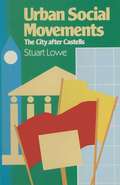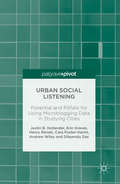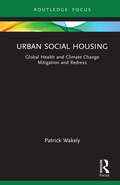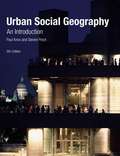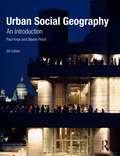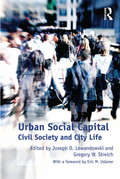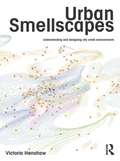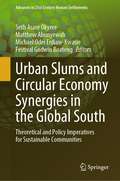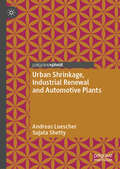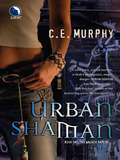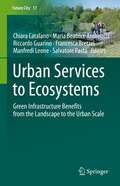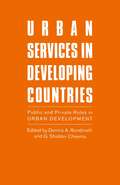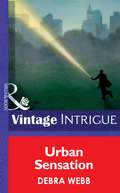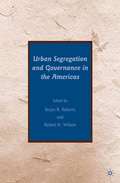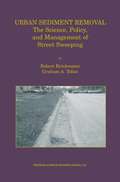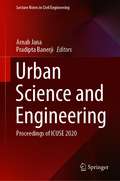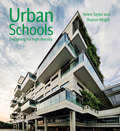- Table View
- List View
Urban Social Listening: Potential and Pitfalls for Using Microblogging Data in Studying Cities
by Justin B. Hollander Erin Graves Cara Foster-Karim Andrew Wiley Dibyendu Das Henry RenskiThis book analyses new software tools and social media data that can be used to explore the attitudes of people in urban places. It reports on the findings of several research projects that have have experimented with using microblogging data in conjunction with diverse quantitative and qualitative methods, including content analysis and advanced multivariate statistics.Applied researchers, planners and policy makers have only recently begun to explore the potential of Big Data to help understand social attitudes and to potentially inform local policy and development decisions. This book provides an original analysis into how Twitter can be used to describe the urban experience and people's perception of place, as well as offering significant implications for public policy. It will be of great interest to researchers in human geography, social media, cultural studies and public policy.
Urban Social Housing: Global Health and Climate Change Mitigation and Redress
by Patrick WakelyThis book proposes operational approaches to public sector support to community-led development of urban low-income group social housing in the prevailing and medium-term. Within the context of mitigating and redressing the existential threats of climate change and global pathogenic transmission, building on current concerns of global heating and the lessons learnt from the 2020-22 COVID-19 pandemic, the book closely examines recent examples from a wide international range of countries and cities from the Sri Lanka experience to Arab States of the Middle East and the Andes. Topics include maintenance and management of public sector housing, poverty alleviation objectives, climate change mitigation, housing density, local land management and planning, land rights, affordable housing markets, and international governance and administration, ultimately pointing to the universal need for institutional, organisational and human skills development and the compilation and dissemination of operationally successful examples of participatory partnerships for affordable social housing. The book will be of interest to researchers, instructors, practitioners, and students of urban development, housing, environmental design, land-use planning, public administration and environmental health engineering.
Urban Social Housing: Global Health and Climate Change Mitigation and Redress
by Patrick WakelyThis book proposes operational approaches to public sector support to community-led development of urban low-income group social housing in the prevailing and medium-term. Within the context of mitigating and redressing the existential threats of climate change and global pathogenic transmission, building on current concerns of global heating and the lessons learnt from the 2020-22 COVID-19 pandemic, the book closely examines recent examples from a wide international range of countries and cities from the Sri Lanka experience to Arab States of the Middle East and the Andes. Topics include maintenance and management of public sector housing, poverty alleviation objectives, climate change mitigation, housing density, local land management and planning, land rights, affordable housing markets, and international governance and administration, ultimately pointing to the universal need for institutional, organisational and human skills development and the compilation and dissemination of operationally successful examples of participatory partnerships for affordable social housing. The book will be of interest to researchers, instructors, practitioners, and students of urban development, housing, environmental design, land-use planning, public administration and environmental health engineering.
Urban Social Geography: An Introduction
by Paul Knox Steven PinchThe 6th edition of this highly respected text builds upon the successful structure, engaging writing style and clear presentation of previous editions. Examining urban social geography from a theoretical and historical perspective, it also explores how it has developed into the modern day. Taking account of recent critical work, whilst simultaneously presenting well established approaches to the subject, it ensures students are well-informed about all the issues. The result is a topical book that is clear and accessible for students
Urban Social Geography: An Introduction (PDF)
by Paul Knox Steven PinchThe 6th edition of this highly respected text builds upon the successful structure, engaging writing style and clear presentation of previous editions. Examining urban social geography from a theoretical and historical perspective, it also explores how it has developed into the modern day. Taking account of recent critical work, whilst simultaneously presenting well established approaches to the subject, it ensures students are well-informed about all the issues. The result is a topical book that is clear and accessible for students
Urban Social Geography: An Introduction
by Paul Knox Steven PinchThe 6th edition of this highly respected text builds upon the successful structure, engaging writing style and clear presentation of previous editions. Examining urban social geography from a theoretical and historical perspective, it also explores how it has developed into the modern day. Taking account of recent critical work, whilst simultaneously presenting well established approaches to the subject, it ensures students are well-informed about all the issues. The result is a topical book that is clear and accessible for students
Urban Social Geography: An Introduction
by Paul Knox Steven PinchThe 6th edition of this highly respected text builds upon the successful structure, engaging writing style and clear presentation of previous editions. Examining urban social geography from a theoretical and historical perspective, it also explores how it has developed into the modern day. Taking account of recent critical work, whilst simultaneously presenting well established approaches to the subject, it ensures students are well-informed about all the issues. The result is a topical book that is clear and accessible for students
Urban Social Capital: Civil Society and City Life
by Gregory W. StreichThis volume presents a kaleidoscopic view of the norms and forms of contemporary city life, focusing especially on the processes of social capital (de)formation in the urban milieu. It brings together studies from highly diverse urban settings, such as squatter re-settlement projects in Kathmandu, urban funeral societies in Africa, an HIV/AIDS community in Los Angeles, the poor of Harare, pensioners in Shanghai, Maori gangs in Auckland, and a Roma boxing club in Prague, among others. Contributors draw on contemporary theory and research in social capital, political economy, urban planning and policy, social movements, civil society and democracy to explore how social norms, networks, connections and ties are created, deployed - and often frayed - under conditions of social complexity, inequality, cultural pluralism, and the ethno-racial diversity and division characteristic of urban contexts throughout the world. In this way, the volume engages in a genuinely globalized - and globalizing - discussion of contemporary urban social life and stands as a unique and timely interdisciplinary contribution to the ever-expanding literature devoted to social capital.
Urban Social Capital: Civil Society and City Life
by Gregory W. StreichThis volume presents a kaleidoscopic view of the norms and forms of contemporary city life, focusing especially on the processes of social capital (de)formation in the urban milieu. It brings together studies from highly diverse urban settings, such as squatter re-settlement projects in Kathmandu, urban funeral societies in Africa, an HIV/AIDS community in Los Angeles, the poor of Harare, pensioners in Shanghai, Maori gangs in Auckland, and a Roma boxing club in Prague, among others. Contributors draw on contemporary theory and research in social capital, political economy, urban planning and policy, social movements, civil society and democracy to explore how social norms, networks, connections and ties are created, deployed - and often frayed - under conditions of social complexity, inequality, cultural pluralism, and the ethno-racial diversity and division characteristic of urban contexts throughout the world. In this way, the volume engages in a genuinely globalized - and globalizing - discussion of contemporary urban social life and stands as a unique and timely interdisciplinary contribution to the ever-expanding literature devoted to social capital.
Urban Smellscapes: Understanding and Designing City Smell Environments
by Victoria HenshawWe see the city, we hear the city, but above all: we smell the city. Scent has unique qualities: ubiquity, persistence, and an unparalleled connection to memory, yet it has gone overlooked in discussions of sensory design. What scents shape the city? How does scent contribute to placemaking? How do we design smell environments in the city? Urban Smellscapes makes a notable contribution towards the growing body of literature on the senses and design by providing some answers to these questions and contributing towards the wider research agenda regarding how people sensually experience urban environments. It is the first of its kind in examining the role of smell specifically in contemporary experiences and perceptions of English towns and cities, highlighting the perception of urban smellscapes as inter-related with place perception, and describing odour’s contribution towards overall sense of place. With case studies from factories, breweries, urban parks, and experimental smell environments in Manchester and Grasse, Urban Smellscapes identifies processes by which urban smell environments are managed and controlled, and gives designers and city managers tools to actively use smell in their work.
Urban Smellscapes: Understanding and Designing City Smell Environments
by Victoria HenshawWe see the city, we hear the city, but above all: we smell the city. Scent has unique qualities: ubiquity, persistence, and an unparalleled connection to memory, yet it has gone overlooked in discussions of sensory design. What scents shape the city? How does scent contribute to placemaking? How do we design smell environments in the city? Urban Smellscapes makes a notable contribution towards the growing body of literature on the senses and design by providing some answers to these questions and contributing towards the wider research agenda regarding how people sensually experience urban environments. It is the first of its kind in examining the role of smell specifically in contemporary experiences and perceptions of English towns and cities, highlighting the perception of urban smellscapes as inter-related with place perception, and describing odour’s contribution towards overall sense of place. With case studies from factories, breweries, urban parks, and experimental smell environments in Manchester and Grasse, Urban Smellscapes identifies processes by which urban smell environments are managed and controlled, and gives designers and city managers tools to actively use smell in their work.
Urban Slums and Circular Economy Synergies in the Global South: Theoretical and Policy Imperatives for Sustainable Communities (Advances in 21st Century Human Settlements)
by Seth Asare Okyere Matthew Abunyewah Michael Odei Erdiaw-Kwasie Festival Godwin BoatengThis book takes a theoretical and empirical distance from urban slums/low-income settlements as a threat to environmental sustainability and recast them as places where environmentally rehabilitative and circular practices occur—drawing on the theoretical lens of the circular economy (CE). CE is defined as regenerative system that minimizes waste, emission, and energy leakage by slowing, closing, and narrowing material and energy loops. In principle, CE departs from the traditional linear model of take-make-use-dispose. As conceived in urban contexts, circular cities offer possibilities to regenerate natural systems, design out waste, and keep products in use. While the CE key principles of reduce, repair, and reuse are essential to the sustainable and inclusive interventions in urban slums, there is lack of case studies exploring the role of place and agency, especially the slum living-CE nexus in global south contexts. In inequitable urban transitions, a nuanced understanding of thesynergies between urban slums and the circular economy is not only theoretically relevant for reconceptualizing the slum in urban sustainability discourses but also exert policy and practice ramifications to decidedly figure out how the urban slum phenomenon can foster the sustainable and inclusive development of marginal areas through contextual and people-centered initiatives.
Urban Shrinkage, Industrial Renewal and Automotive Plants
by Andreas Luescher Sujata ShettyThis book focuses on the relationship between the auto industry and the built environment at multiple scales, a topic of particular interest now as the industry is going through a period of major transformation. Drawing from multiple perspectives, including architecture, urban design and urban planning, the authors examine the changing form of the auto factory itself, the changing geography of auto production, and the challenges faced by communities as the auto plants that once brought them prosperity, and often a sense of identity, leave town. They examine four places that are dealing in different ways, and with varying success, with the aftermath of a decommissioned auto plant in their midst. These are Janesville, Wisconsin, and Willow Run, Michigan, in the U.S., and Bochum, Germany, and Genk, Belgium, in Europe. Together these four cases provide some clues about what the future might look like for places that were once intimately connected with the manufacture of cars.
Urban Shaman: The Walker Papers (The Walker Papers #1)
by C.E. MurphyJoanne Walker has three days to learn to use her shamanic powers and save the world from the unleashed Wild Hunt. No worries. No pressure.
Urban Services to Ecosystems: Green Infrastructure Benefits from the Landscape to the Urban Scale (Future City #17)
by Chiara Catalano Maria Beatrice Andreucci Riccardo Guarino Francesca Bretzel Manfredi Leone Salvatore PastaThe aim of this book is to bring together multidisciplinary research in the field of green infrastructure design, construction and ecology. The main core of the volume is constituted by contributions dealing with green infrastructure, vegetation science, nature-based solutions and sustainable urban development. The green infrastructure and its ecosystem services, indeed, are gaining space in both political agendas and academic research. However, the attention is focused on the services that nature is giving for free to and for human health and survival. What if we start to see things from another perspective? Our actions shall converge for instance to turn man-made environment like cities from heterotrophic to autotrophic ecosystems. From landscape ecology to urban and building design, like bricks of a wall, from the small scale to the bigger landscape scale via ecological networks and corridors, we should start answering these questions: what are the services that are we offering to Nature? What are we improving? How to implement our actions? This book contains three Open Access chapters, which are licensed under the terms of the Creative Commons Attribution 4.0 International License (CC BY 4.0).
Urban Sensation (Eclipse #13)
by Debra WebbDetective Rowen O'Connor never expected she'd come face-to-face with Evan Hunter–the enigmatic man who'd broken her heart years ago–especially not while working a murder investigation that left the city of Boston overrun with panic.
Urban Segregation and Governance in the Americas
by B. Roberts R. WilsonResidential segregation is a key issue for good governance in Latin American cities. The isolation of people of different social classes or ethnicities has potential political and social consequences, including differential access to and quality of education, health and other services. This volume uses the recent availability of geo-coded census data and techniques of spatial analysis to conduct the first detailed comparative examination of residential segregation in six major Latin American metropolises, with Austin, Texas, as a US comparison. It demonstrates the high degree of residential segregation of contemporary Latin American cities and discusses implications for the welfare of urban residents.
Urban Sediment Removal: The Science, Policy, and Management of Street Sweeping
by Robert Brinkmann Graham A. TobinThere is not an extensive literature on street sweeping. Much of the research that has been completed exists in the "gray" area of technical reports and government documents. Furthermore, a great deal of this research is locally based, and has not been widely published. Indeed, our review of the scientific literature, revealed that, while storm water quality has received a lot of attention, few academicians have been involved in street sweeping research per se. Thus, throughout our research into street we sweeper effectiveness, sweeping protocols, and sweeping practices, wished that there had been a book summarizing some of the important issues associated with street sweeping. As our frustration grew, we realized that we were uniquely poised to write such a book as our research had encompassed a variety of different projects including sweeper testing, waste management, and related storm water quality. Also, early on in this exercise, we recognized that there was a growing demand for information about street sweeping policies and management, especially for studies focusing on the effectiveness of different sweeping schedules, on waste management operations, and on non-point, pollution reduction practices associated with storm water runoff. It was abundantly clear that there was a profound lack of research on street sweeping that could assist with developing local, regional, or national policies. There was, in effect, little guidance for city managers on these issues.
The Urban Section: An analytical tool for cities and streets
by Robert ManthoThe design of streets, and the connections between streets of different character, is the most important task for architects and urbanists working in an urban context. Considered at two distinct spatial scales – that of the individual street – the Street Section – and the complex of city streets – the City Transect – Urban Section identifies a range of generic street types and their success or otherwise in responding to climatic, cultural, traditional, morphological, social and economic well being. Using comparative studies a profile of best practice in street and city design is identified, showing methodologies in both the analysis of, and design for, successful streets and public places – place-making. In uniquely dealing with both the historic and contemporary description and analysis of urban ‘streets’ around the world, the work is of both academic and professional interest to architects, urban planners and designers, highway engineers, landscape and urban design advisers in both the public and private sectors; students, amenity and civic societies, city authorities and government agencies.
The Urban Section: An analytical tool for cities and streets
by Robert ManthoThe design of streets, and the connections between streets of different character, is the most important task for architects and urbanists working in an urban context. Considered at two distinct spatial scales – that of the individual street – the Street Section – and the complex of city streets – the City Transect – Urban Section identifies a range of generic street types and their success or otherwise in responding to climatic, cultural, traditional, morphological, social and economic well being. Using comparative studies a profile of best practice in street and city design is identified, showing methodologies in both the analysis of, and design for, successful streets and public places – place-making. In uniquely dealing with both the historic and contemporary description and analysis of urban ‘streets’ around the world, the work is of both academic and professional interest to architects, urban planners and designers, highway engineers, landscape and urban design advisers in both the public and private sectors; students, amenity and civic societies, city authorities and government agencies.
Urban Science and Engineering: Proceedings of ICUSE 2020 (Lecture Notes in Civil Engineering #121)
by Arnab Jana Pradipta BanerjiThis book comprises select proceedings of the First International Conference on Urban Science and Engineering. The focus of the conference was on the milieu of urban planning while applying technology which ensures better urban life, coupled with sensitivity to depleting natural resources and focus on sustainable development. The contents focus on sustainable infrastructure, mobility and planning, urban water and sanitization, green construction materials, optimization and innovation in structural design, and more. This book aims to provide up-to-date and authoritative knowledge from both industrial and academic worlds, sharing best practice in the field of urban science and engineering. This book is beneficial to students, researchers, and professionals working in the field of smart materials and sustainable development.^
Urban Schools: Designing for High Density
by Helen Taylor Sharon WrightWhen space is tight how can a city provide the best education experience for children? Is a multi-storey school really a poor option? Can high-quality play opportunities be provided without playgrounds? This book explores the design of schools in urban settings, the increased challenges in meeting the typical expectations of school design, and what the successful new typology of a school in a city might be. A practical guide as well as a theoretical exploration of ideas, this book outlines successful international contemporary and historical case studies, providing much-needed guidance for architects and others working in education design in dense urban environments.
